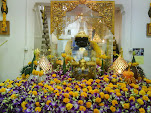

象神 Ganesha or Ganesh 他是福德之神,也是知識智慧之神(Lord of Wisdom),在眾多印度神祇當中,受歡迎的程度相當高 Ganesha是象頭人身,他是印度三大神之一(Hindu Trinity)的破壞神濕婆神(Shiva)和雪山女神帕瓦蒂(Parvati)的大兒子。
他的出生故事相當有趣,是印度神話中非常著名的一段。一日,一向遁世而居的Shiva又離家數日,深入雪山冥想修行,妻子Parvati一向渴望溫暖的家庭,於是就自行使用法力,將身上的灰垢變成一個小男孩。喜為人母的Parvati就令小男孩為她守護山洞口,讓她好好休憩一番。返家的Shiva完全不知自己多了個兒子,就與忠誠守護洞口、抵死不讓Shiva進入山洞的小男孩起了衝突,Shiva一怒之下就把小孩的頭給砍了。接下來,為了安撫傷心欲絕的太太,Shiva把路過的第一個生物,也就是一頭大象的頭給砍了下來,安置在男孩的身體上,於是就成了象頭人身的大象神Ganesha。
Ganesha有Parvati女神給的身體,Shiva安置的象頭,於是堪稱為陰陽和諧的完美呈現.Ganesha也是福德之神,也就是我們的財神,想生財的都要拜拜他。Ganesh在神話中是女神的守護者,在此也代表著福德之神,去除不好的障礙。
据知,象头神一共有卅二大化身,时而3头,4头,时而4手,6手,8手,多手,时而青肤、红肤、黄肤、黑肤。他造型的特别点是断了右旁的弯象牙,有时那半截象牙握在其中一只手上。半截的折牙象征着,世上不会有完好理想的命运,凡要达到成功,知识或智慧,都要作出牺牲。象头神在天界是大门的守者,所以他经常坐在四瓣莲花所化的檀城上,他管理了记忆及知识所能到的范围,以监督记忆,原因,影响力,推动力,爱及隔离感六种,所以在鼻上绑了一个铃子,以作为警惕。
象头神的神诞是在印度AVANI月(阳历八至九月间)月圆之日。
Ganesha — the elephant-deity riding a mouse — has become one of the commonest mnemonics for anything associated with Hinduism. This not only suggests the importance of Ganesha, but also shows how popular and pervasive this deity is in the minds of the masses.
The Lord of SuccessThe son of Shiva and Parvati, Ganesha has an elephantine countenance with a curved trunk and big ears, and a huge pot-bellied body of a human being. He is the Lord of success and destroyer of evils and obstacles. He is also worshipped as the god of education, knowledge, wisdom and wealth. In fact, Ganesha is one of the five prime Hindu deities (Brahma, Vishnu, Shiva and Durga being the other four) whose idolatry is glorified as the panchayatana puja.
Ganesha's head symbolizes the Atman or the soul, which is the ultimate supreme reality of human existence, and his human body signifies Maya or the earthly existence of human beings. The elephant head denotes wisdom and its trunk represents Om, the sound symbol of cosmic reality. In his upper right hand Ganesha holds a goad, which helps him propel mankind forward on the eternal path and remove obstacles from the way. The noose in Ganesha's left hand is a gentle implement to capture all difficulties.
The broken tusk that Ganesha holds like a pen in his lower right hand is a symbol of sacrifice, which he broke for writing the Mahabharata. The rosary in his other hand suggests that the pursuit of knowledge should be continuous. The laddoo (sweet) he holds in his trunk indicates that one must discover the sweetness of the Atman. His fan-like ears convey that he is all ears to our petition. The snake that runs round his waist represents energy in all forms. And he is humble enough to ride the lowest of creatures, a mouse.
Ganesha, the Destroyer of PrideGanesha is also the destroyer of vanity, selfishness and pride. He is the personification of material universe in all its various magnificent manifestations.
The Lord of SuccessThe son of Shiva and Parvati, Ganesha has an elephantine countenance with a curved trunk and big ears, and a huge pot-bellied body of a human being. He is the Lord of success and destroyer of evils and obstacles. He is also worshipped as the god of education, knowledge, wisdom and wealth. In fact, Ganesha is one of the five prime Hindu deities (Brahma, Vishnu, Shiva and Durga being the other four) whose idolatry is glorified as the panchayatana puja.
Ganesha's head symbolizes the Atman or the soul, which is the ultimate supreme reality of human existence, and his human body signifies Maya or the earthly existence of human beings. The elephant head denotes wisdom and its trunk represents Om, the sound symbol of cosmic reality. In his upper right hand Ganesha holds a goad, which helps him propel mankind forward on the eternal path and remove obstacles from the way. The noose in Ganesha's left hand is a gentle implement to capture all difficulties.
The broken tusk that Ganesha holds like a pen in his lower right hand is a symbol of sacrifice, which he broke for writing the Mahabharata. The rosary in his other hand suggests that the pursuit of knowledge should be continuous. The laddoo (sweet) he holds in his trunk indicates that one must discover the sweetness of the Atman. His fan-like ears convey that he is all ears to our petition. The snake that runs round his waist represents energy in all forms. And he is humble enough to ride the lowest of creatures, a mouse.
Ganesha, the Destroyer of PrideGanesha is also the destroyer of vanity, selfishness and pride. He is the personification of material universe in all its various magnificent manifestations.
胡


No comments:
Post a Comment